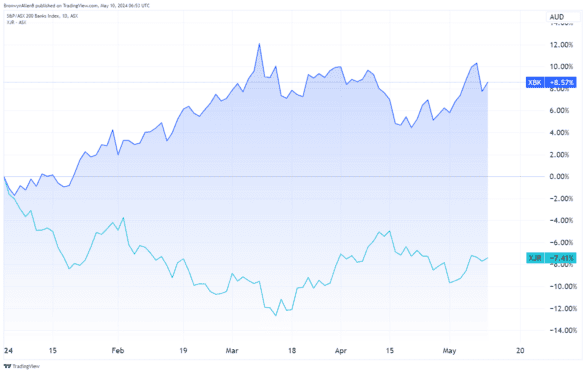ASX 200 mining stocks have vastly underperformed ASX 200 bank stocks in recent months.
Take a look at this chart below comparing the S&P/ASX 200 Banks Index (ASX: XBK) and the S&P/ASX 200 Resources Index (ASX: XJR) in the year to date.
ASX 200 bank stocks have risen 8.57% whilst ASX 200 resources stocks have lost 7.41% of their value.
This is an interesting situation, given the mining and banking stocks comprise a huge proportion of the ASX 200's total market capitalisation.
With one going up and one going down, is it any wonder the S&P/ASX 200 Index (ASX: XJO) is virtually flat in the year to date at 7,749 points, up just 1.59%?

So, what's going on?
Ray David, Portfolio Manager and Partner at Blackwattle Investment Partners discussed the divergent performance between the two stock types in a recent interview with ausbiz.
Why are ASX 200 mining stocks underperforming bank stocks?
In terms of ASX 200 mining stocks, David explained that the market is concerned about the iron ore price amid weakness in China's property market.
This has weighed on the performance of mega iron ore shares BHP Group Ltd (ASX: BHP), down 15% in the year to date, and Rio Tinto Ltd (ASX: RIO), down 4.8% in the year to date.
David says there's an opportunity for investors to snap up weakened BHP and Rio Tinto shares while commodity prices are rising.
He said:
So you've seen softer property sales, softer property prices, and a lack of stimulus [in China]. So that's really weighed on Rio and BHP. But if you actually look at underlying commodities for RIO and BHP, iron ore is up about 12% over one year, and copper — which is about 25 to 30% of earnings — is up by about 17%, so we think there's a real opportunity for investors …
In terms of ASX 200 bank stocks, David said the banks "look like they've overstretched on valuations".
… so banks are trading about … 16x earnings. Markets have gotten excited that bad debts really won't tick up but we still think there'll be some pressure there.
In terms of deciding between ASX 200 mining stocks vs. bank stocks, David sums it up:
… the concerns around demand for iron ore and copper in our view are probably too cautious, and so there's an opportunity for investors to be overweight materials because the valuation multiples are a lot cheaper than the banks. They're trading on 11x, 12x cash earnings.
Which other miners are a buy?
David said Blackwattle looks for mining stocks that tick four boxes:
- Low-cost
- Long reserve lives
- Strong balance sheets
- Good management.
One of his ASX 200 mining stock picks is lithium producer IGO Ltd (ASX: IGO).
He describes decarbonisation as "a theme for the next century". It will mean the adoption of much more electrification and a reduction in fossil fuels and emissions.
He says there are four commodities that stand to benefit most from decarbonisation. They are lithium, copper, rare earths and aluminium.
David said:
So the way we're playing decarbonisation is through our ownership in … IGO.
IGO owns a 25% interest in the lowest-cost spodumene producer in the world. So, the Greenbushes mine, it's producing under US$400 dollars a tonne, that's well below the current spodumene lithium price of US$1,100 a tonne.
And again, it's long reserve life, so a mine life out to 2040; it's got no debt so the balance sheet will see you get through the volatility of commodity prices, and also there's a management team that's now in place that's focusing on improving shareholder outcomes because the previous management team did destroy some value through some poor acquisitions in nickel.
David admits "the market hates lithium at the moment" following a 52% decline in commodity prices over 12 months.
But he said Blackwattle sees the demand profile for lithium in the future as quite strong.
… and if you're producing at the lowest cost, you'll be able to produce lots of cash flow for shareholders, which IGO should, and again the valuation is attractive, with no debt on the balance sheet.
IGO shares finished the session on Friday at $7.92 apiece, down 0.25%. The ASX 200 lithium mining stock has fallen 13% in the year to date.




